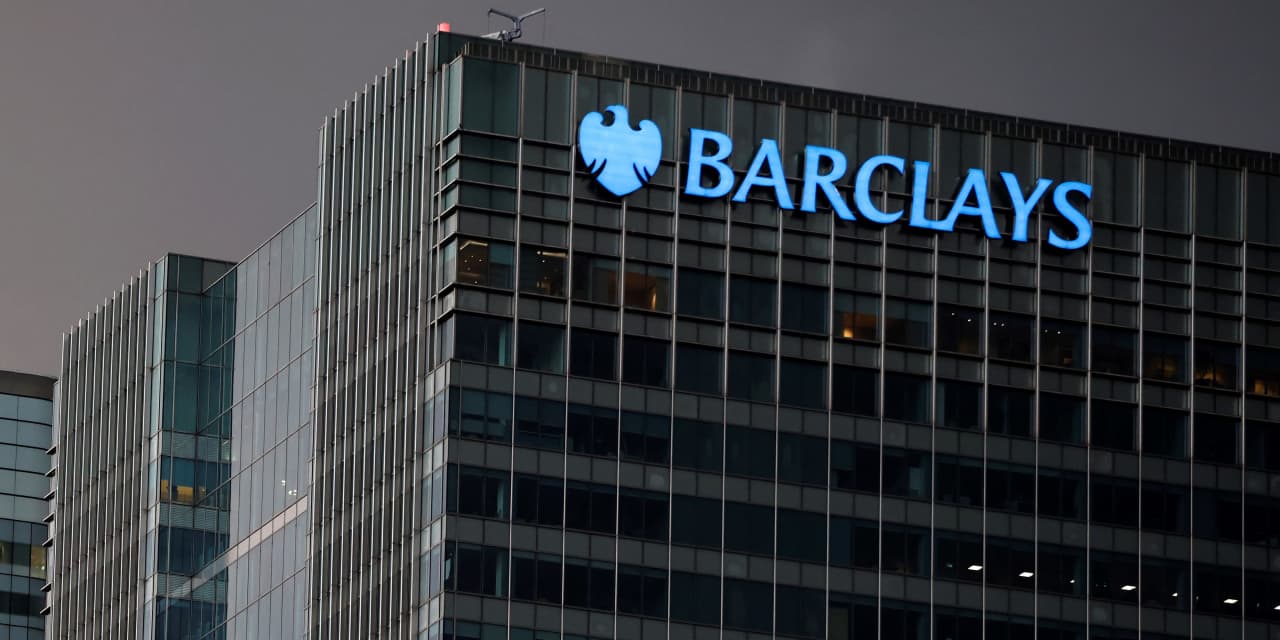Barclays’ U.S.-listed stock turned in its largest one-day gain in more than three years on Tuesday as the British bank outlined plans to restructure its business with a view to cutting its costs by £2 billion (equivalent to $2.5 billion) over the next two years.
As part of the plan, Barclays plans to boost shareholder returns by paying out £10 billion in share buybacks and dividends between now and 2026.
Barclays’
BCS,
stock was up by 11.8%, to $8.35. The stock is on pace for its largest percentage increase since its 18.8% jump on Nov. 9, 2020, according to Dow Jones Market Data.
The stock is also headed for its highest close since July 26, when it ended the session at $8.60 a share.
The stock has risen for four consecutive days, with a combined gain of 17.3% over the period.
In a bid to lift its sliding share price, the British bank plans to restructure itself into five new segments over the next three years: a U.K. bank, a U.S. consumer bank, a U.K corporate bank, an investment bank and a private-banking and wealth-management division.
Barclays laid out the plans in a presentation Tuesday and said the overhaul is aimed at “driving higher returns, and predictable, attractive shareholder distributions,” according to a statement.
Barclays’ U.K.-listed stock
BARC,
went up 4% on Tuesday, after dropping by 11% over the previous 12 months. The financial firm has generated a series of underwhelming results due to a slowdown in its investment-banking division.
The London lender aims to reduce its £17 billion annual costs by £2 billion by reducing its headcount and cutting the size of its property portfolio, with a view to savings of £1 billion in 2024 alone.
Barclays is also aiming to boost its total income to £30 billion a year by 2026, up from £25.37 billion in full-year 2023. Analysts at Citi, led by Andrew Coombs, said they expect Barclays’ investment-banking arm will drive this income growth — accounting for £2.7 billion of this £4.6 billion increase — with the remaining £1.9 billion coming from its retail and corporate businesses.
The bank’s plans followed an underwhelming set of results for full-year 2023, during which Barclays fell short of analysts’ expectations, posting a 6% drop in its pretax profits to £6.56 billion ($8.26 billion), missing consensus estimates by 2%.
The London lender’s profits were dragged down by a 5% drop in revenue from its corporate- and investment-banking division, which generates more than half its total income, and a 12% uptick in its operating costs to £16.93 billion, including a £0.9 billion hit related to its restructuring.
The overhaul plans come as Barclays’ CEO C.S. Venkatakrishnan, who is known as Venkat inside the company, is facing mounting pressure to reverse the bank’s fortunes following a decline that has seen the share price drop 19% since he took control in November 2021.
“Overall, we think that management’s plans could imply double-digit upgrades to consensus forecasts at face value, but with the plans reliant on revenue growth (including IB), the focus is likely to be on the conviction and details behind the targets, along with confidence in execution,” J.P. Morgan Cazenove analysts led by Raul Sinha said.
Read the full article here




